Bridging the GAP between Geological, Archaeological and Palynological studies
Principal Investigator at ZRC SAZU
Maja Andrič, PhD-
Acronym
GAP
Project Team
Nina Caf, PhD, Tjaša Tolar, PhD, Elena Leghissa, PhD, Anton Velušček, PhD, Drago Valoh, Tilen Podobnik, Andrej Šmuc, PhD, Nastja Rogan Šmuc, PhD-
Project ID
J7-60115
-
Duration
1 January 2025–31 December 2027 -
Project Leader
-
Financial Source
Slovenian Research and Innovation Agency

Partners
Univerza v Ljubljani, NTF, Oddelek za geologijo
AIMS OF THE PROJECT
This project aims to investigate Lateglacial and Holocene lake and wetland sediments at Ljubljansko barje basin (Central Slovenia). We will study changes of vegetation in the last 15.000 years to better understand long-term environmental changes. Multidisciplinary research of sedimentary cores and stratigraphic columns from archaeological sites (Figure 1) will include: radiocarbon dating of plant macrofossils/organic sediment, geological (mineralogy, sedimentology, geochemistry) and palynological (pollen, microcharcoal) research. These results will be compared with archaeological settlement pattern, and palaeoecological research in other regions, e.g. Julian Alps, where detailed palaeoecological research was already carried out.

Ljubljansko barje and Julian Alps study area. In Ljubljansko barje, palaeoecological research will be carried out in vicinity of Neo/Eneolithic archaeological sites Verd, Stare gmajne and Dušanovo (5th-3rd millennium cal. BC).
The following research questions will be addressed:
- What were the changes in the geochemical composition of the sediment and vegetation during the Lateglacial and Holocene?
- Do they coincide? Were changes in the geochemical record triggered by changes in the vegetation or the other way around?
- Which changes can be attributed to climate change or human impact? Do they agree with the results of archaeological and palaeoclimatological research?
- Which changes occur simultaneously at all study sites (in the Julian Alps and in Ljubljansko barje) and correspond to similar changes in the wider environment (Europe)?
- How does the type of study site (large/small lake, wetland), different elevations and different bedrock affect the visibility of palaeoenvironmental processes in geochemical and palynological records?
- What are the thresholds for landscape stability, what are the triggers for instability in the geochemical record and for vegetation change?
- How did the stability/instability of the landscape affect people, the economy, and settlement patterns in different archaeological periods?

SCIENTIFIC BACKGROUD
Climatic fluctuations, hydrological changes and human activities in the landscape can trigger changes of vegetation and geochemical composition of the sediment. However, palaeoenvironmental processes are complex and vary throughout millennia. Therefore, muti-proxy investigation of lake/wetland palaeoenvironmental archives, combined with studies of past human society are needed to better understand the role of each of these ‘driving forces’.
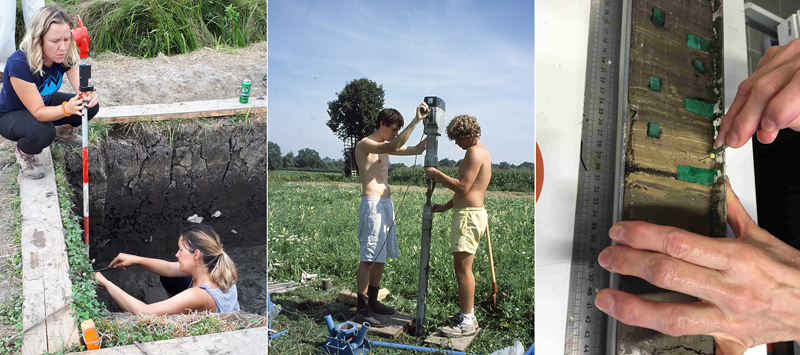
In Ljubljansko barje a very detailed geological analysis of the Holocene sediment will be carried out for the first time, which will help us to study the impact of agriculture, grazing and metallurgical activities on the environment of the southeastern Alps. The interplay between hydroseral succession and other drivers of environmental change (climate, humans) will be investigated. The proposed research project is also crucial for the development of new research methods. Other studies in this field of science focus only on studies of the geochemical composition of lake sediments, or only on studies of vegetation and human impact in different archaeological periods. This research project aims to bridge the gap between geological, archaeological and palynological research, in two different regions, and at different study sites (lakes, wetlands) where systematic archaeological research has been carried out for decades. We will also investigate the sensitivity of the different study sites (small/large lakes and wetlands) to climatic variations and human activities.
Finally, the results from Ljubljansko barje and Julian Alps will be compared to examine differences/similarities between the regions. We will address the question of which environmental changes were more important for human society in these contrasting environments, e.g. hydrological changes in Ljubljansko barje vs. the impact of temperature changes on the vegetation belts of the Julian Alps. These changes of the environment will be compared with environmental changes in the wider region, and with palaeoclimate data showing larger climate fluctuations (e.g. 8.2 ka, 4.2 ka BP, LIA events) which will help us to understand climatic variability and synchrony (i.e. leads and lags) in the Holocene.
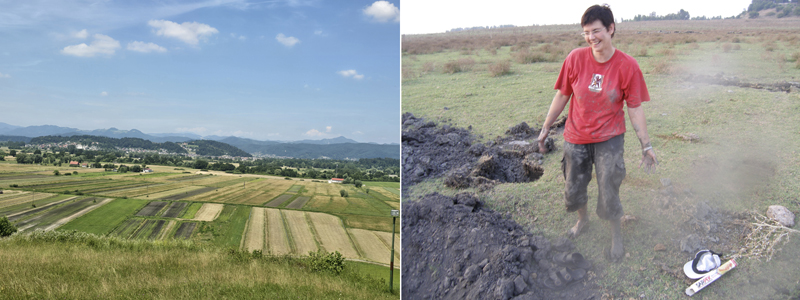
Ljubljansko barje is one of the most important archaeological regions in Europe. The prehistoric pile-dwelling settlements (5th–2nd millennium cal. BC) which were discovered in this area are on the UNESCO cultural heritage list. They exhibit a rich material culture and due to the wet hydrological conditions the preservation of the palaeoecological record is excellent. The Ljubljansko barje wetland is one of the southernmost (ombrotrophic) lowland peatlands in Europe and an important habitat for many plant and animal species. This research will help us to understand how species, habitat types and biodiversity have evolved over time and how to protect them.
TO SUMMARISE
Previous research in Ljubljansko barje indicates that changes in vegetation and hydrology in the past were very dynamic and, surprisingly, often occurred simultaneously, suggesting that the impact of climate variability could have been significant. However, in this very complex and ancient anthropogenic landscape, several ecological processes (hydroseral succession of infilling lake and changes in vegetation and hydrology due to climate variability and human impacts) occurred simultaneously. Therefore, to better understand the role of each of these three factors (succession, climate, human influence), more detailed multiproxy research is needed to assess which environmental events (e.g. water level changes, flooding, soil erosion) were local and which were regional, and what were the main drivers of changes in vegetation and hydrology.
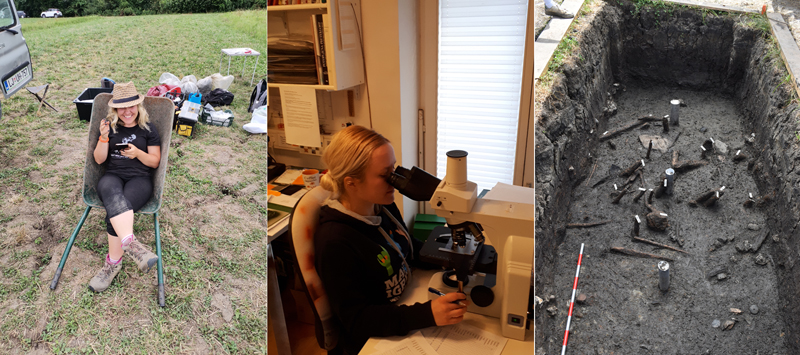
The aim of this project is therefore to carry out detailed geological and palynological investigations in Ljubljansko barje and compare these results with the existing data for the Julian Alps. This will help us to better understand whether vegetation development was similar in both regions, what influence humans had on the vegetation during the different archaeological periods, and how they adapted to environmental changes. We will be able to compare whether floods and erosion events occurred at the same time in both regions (and were possibly climatically induced), or whether they were also influenced by human activities. We will also investigate where the thresholds for (irreversible) environmental change are and how sensitive the different study sites (small/large lakes and wetlands) are to climate variability and human activities.
PROJECT GROUP
ZRC SAZU (Institute of archaeology):
- Maja Andrič (palynological research)
- Nina Caf (palynological and geological research)
- Tjaša Tolar (archaeobotanical research)
- Elena Leghissa (archaeological research)
- Anton Velušček (archaeological research)
- Drago Valoh (fieldwork support and the preparation of illustrations)
- Tilen Podobnik (fieldwork support)
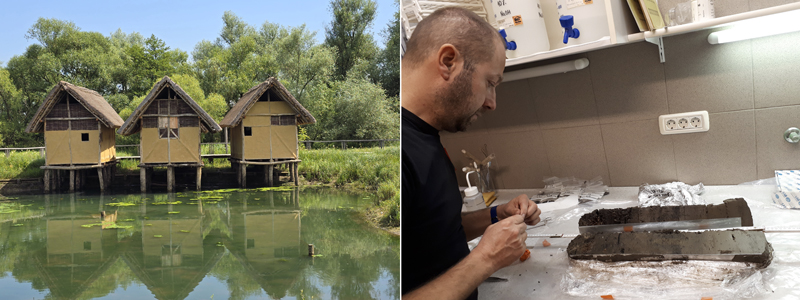
University of Ljubljana (NTF, Department of geology):
- Andrej Šmuc (geological research: mineralogy, sedimentology, geochemistry)
- Nastja Rogan Šmuc (geological research: mineralogy, sedimentology, geochemistry)
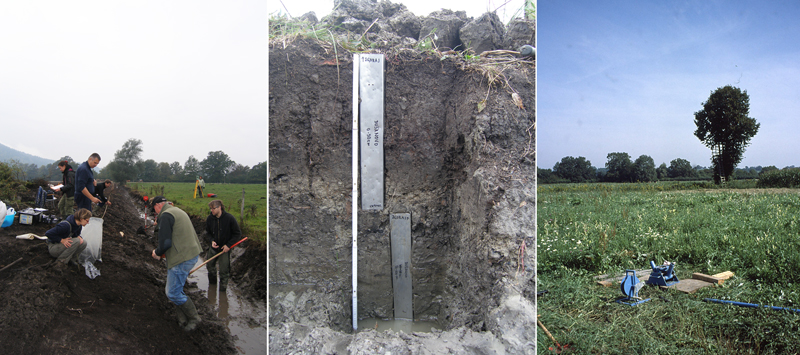
Two types of activities will be carried out: palaeoecological (WP1, WP2) and archaeological (WP3) research, organised in 4 work packages (WP1-4)
WP1: Palynological and archaeobotanical research, radiocarbon dating
High-resolution analysis of Stare gmajne sediment core (7m, ca. 12.000-4000 cal. BP) and 3 stratigraphic columns taken during archaeological excavations at: Dušanovo, Stare gmajne and Verd (all ca. 1.5 m long, ca. 6000-4000 cal BP)
WP2: Mineralogical, sedimentological and geochemical research
High-resolution analysis of the same samples as WP1
WP3: Archaeological research
Analysis of material from 2021 excavations at Stare gmajne and existing data on past human activities will be compared with the results of the palaeoecological research.
WP4: WP4: Data analysis, publications and dissemination of results The results of WP1, 2 and 3 will be analysed and compared. All researchers will participate in this task. Studies focusing on the periods of the most intensive settlement in Ljubljansko barje and Julian Alps and relations between people and the natural environment will be prepared and put in a wider, European context.

Timetable
MILESTONES
Year 1
- palaeoecological (WP1 and 2) and archaeological research (WP3) at Dušanovo completed
- project websit prepared
Year 2
- palaeoenvironmental (WP1 and 2) and archaeological research (WP3) of Verd and Stare gmajne stratigraphic columns completed - results will be presented at international conferences (e.g. IWGP, EAA, EGU)
Year 3
- all laboratory work (including Stare gmajne core) and archaeological research completed map of archaeological sites in both regions prepared
- the final results of the research project will be presented at major international conferences (e.g. INQUA 2027)
- project website updated, the final results of the project will be presented to wider public (e.g. media, local communities, schools,…)
- analysis of all data completed, (joint) publications submitted and in review process